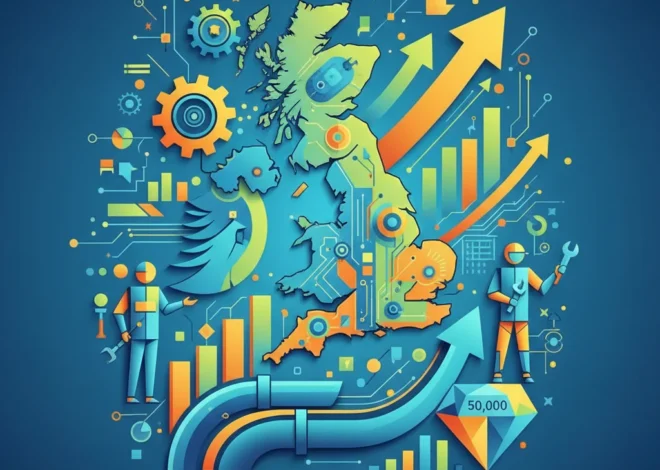
Sunshine and Spending: Is the UK’s Retail Surge a True Economic Dawn or a Weather-Driven Mirage?
In a surprising turn that has captured the attention of economists and investors alike, the UK’s retail sector has just posted its most robust monthly sales figures since 2022. According to a recent report from the Office for National Statistics (ONS), a spell of favorable weather acted as a powerful catalyst, encouraging consumers to refresh their wardrobes and step back into high-street stores. Sales volumes saw a significant jump, painting a rare stroke of bright color on an economic canvas that has long been dominated by shades of grey.
This news offers a welcome reprieve from the persistent narrative of high inflation and cautious consumer sentiment. But as business leaders and participants in the stock market digest this information, a critical question emerges: Is this surge a sign of genuine, sustainable economic recovery, or merely a fleeting, sun-induced spending spree? This article delves deep into the data, explores the wider economic context, and analyzes the implications for investing, business strategy, and the future of the UK economy.
A Deeper Dive into the Data: Beyond the Headline Figure
While the headline growth is encouraging, a granular look at the components of the retail sales index reveals a more nuanced story. The ONS report highlights that the primary driver was a significant uptick in clothing and footwear sales, a category notoriously sensitive to seasonal changes. To better understand the dynamics at play, let’s break down the performance across key retail sectors.
The table below provides a hypothetical but illustrative breakdown of month-on-month sales volume growth, reflecting the trends described in the ONS findings.
| Retail Sector | Monthly Sales Volume Growth (%) | Key Contributing Factors |
|---|---|---|
| Clothing & Footwear Stores | +5.4% | Warm weather driving demand for summer apparel; return to in-person events. |
| Household Goods Stores | +2.1% | Increased spending on garden furniture and DIY projects. |
| Food Stores (Supermarkets) | +1.2% | Stable growth, slightly boosted by BBQ and picnic-related purchases. |
| Non-Store Retailing (Online) | +1.5% | Slower growth as consumers returned to physical stores, but remains resilient. |
| Overall Retail Sales | +2.9% (source) | Highest monthly rise since early 2022. |
As the data indicates, the outsized performance of discretionary categories like fashion and home goods powered the overall increase. This pattern suggests that when given a reason—in this case, sunshine—consumers are willing to open their wallets for non-essential items. This is a tentative but positive indicator of improving consumer confidence, a vital ingredient for a robust economy. However, the relatively modest growth in essential categories like food stores underscores that household budgets remain under pressure.
London's Blueprint for a Building Boom: What Planning Reform Means for the UK Economy and Investors
Connecting the Dots: Retail Sales in the Broader Economic Landscape
A single month’s retail data, however strong, does not exist in a vacuum. Its true significance is revealed only when viewed within the broader tapestry of macroeconomic indicators. For professionals in finance and economics, this report serves as a crucial data point for assessing the health of the UK’s consumer-driven economy.
Several interconnected factors are at play:
- Inflation and Monetary Policy: The UK has been grappling with elevated inflation, which erodes purchasing power. Recent data suggesting that inflation is beginning to cool may have contributed to this retail uptick. Consumers who feel the pressure of rising prices easing are more likely to spend. This, in turn, influences the Bank of England’s decisions on interest rates. Stronger consumer spending could delay potential rate cuts, a key consideration for the banking sector and for those involved in bond trading.
- Consumer Confidence Index: This retail surge will be closely compared with upcoming consumer confidence surveys. A corresponding rise in confidence would suggest a more fundamental shift in public sentiment. Conversely, if confidence remains stagnant, it would reinforce the theory that this sales boom is an anomaly rather than the start of a new trend. According to GfK’s long-running survey, confidence has been improving from historic lows, and this retail data could provide a further boost.
- Stock Market Reaction: The stock market is often a forward-looking indicator. Following this news, we can expect analysts to re-evaluate their positions on consumer discretionary stocks (e.g., retailers, travel companies) versus consumer staples (e.g., supermarkets, utility companies). A sustained retail recovery could trigger a rotation of capital into sectors that benefit from increased consumer spending, impacting investment portfolios and market indices.
The Unseen Engine: Financial Technology’s Role in Modern Retail
Beyond the weather, another powerful, and more permanent, force is shaping these spending patterns: the relentless advance of financial technology. The modern retail experience, both online and in-store, is fundamentally different from that of a decade ago, thanks to innovations in fintech.
The ease and seamlessness of modern payment systems undoubtedly lower the friction to spend. Technologies such as contactless payments, digital wallets (Apple Pay, Google Pay), and the rise of Buy Now, Pay Later (BNPL) services empower consumers to make purchases with unprecedented speed. This digital transformation was accelerated by the pandemic but has now become the standard expectation, contributing to overall sales velocity. Retailers who have invested heavily in their omnichannel and fintech infrastructure are best positioned to capture this renewed consumer enthusiasm. Further on the horizon, some innovators are exploring how blockchain technology could enhance supply chain transparency and create more secure payment rails, signaling the next wave of disruption in the sector.
The Trillion-Dollar Shift: How a Rare Earth 'Quake' is Redefining Global Finance and Technology
Actionable Insights for Investors and Business Leaders
This latest economic data point is not just an academic curiosity; it has tangible implications for strategic decision-making.
For the Investor:
Navigating the investing landscape requires looking past the headlines. This report suggests several potential strategies:
- Sector-Specific Analysis: Don’t just buy “retail.” Differentiate between the winners and losers. The data shows strength in discretionary spending. Investors might look closer at well-managed fashion and home goods companies with strong brand loyalty and efficient supply chains. As one financial analyst noted, “the ability to manage inventory effectively in response to sudden demand spikes, like the one we just saw, is a key performance indicator” (source).
- Watch Macro Indicators: This retail data is one piece of the puzzle. Keep a close eye on inflation reports, employment figures, and central bank commentary. These will provide crucial context for your trading and long-term investment decisions.
- Consider the Enablers: Sometimes, the most profitable investment isn’t the retailer itself, but the companies that power them. This includes logistics firms, e-commerce platform providers, and, crucially, fintech and payment processing companies.
For the Business Leader:
For those at the helm of businesses, the takeaways are about agility and adaptation:
- Embrace Omnichannel Agility: The report showed a partial return to physical stores, reinforcing that a hybrid “phygital” strategy is essential. A seamless experience across online and in-store channels is no longer a luxury but a necessity.
- Leverage Data Analytics: The businesses that won this month were those that anticipated the shift in demand. Using predictive analytics to manage inventory and marketing in response to external factors like weather forecasts is a powerful competitive advantage.
- Invest in Customer Experience: With budgets still tight, consumers are discerning. A smooth, technologically advanced checkout process, personalized offers, and excellent customer service can be the deciding factor that captures a share of their renewed spending appetite.
Conclusion: A Sunny Outlook with a Chance of Clouds
The surge in UK retail sales is unequivocally good news, offering a glimmer of hope that the consumer engine of the economy is sputtering back to life. It reflects a potential easing of inflationary pressures and a willingness among households to spend on discretionary goods when conditions are right.
However, attributing this victory solely to a fundamental economic recovery would be premature. The strong influence of temporary factors like the weather demands a cautious, data-driven approach. For investors, business leaders, and financial professionals, the message is clear: while it’s time to be optimistic, it’s not yet time to be complacent. The coming months will be critical in determining whether this sunny spell in retail is the beginning of a new, prosperous season for the UK economy or just a pleasant but fleeting moment in the sun.


